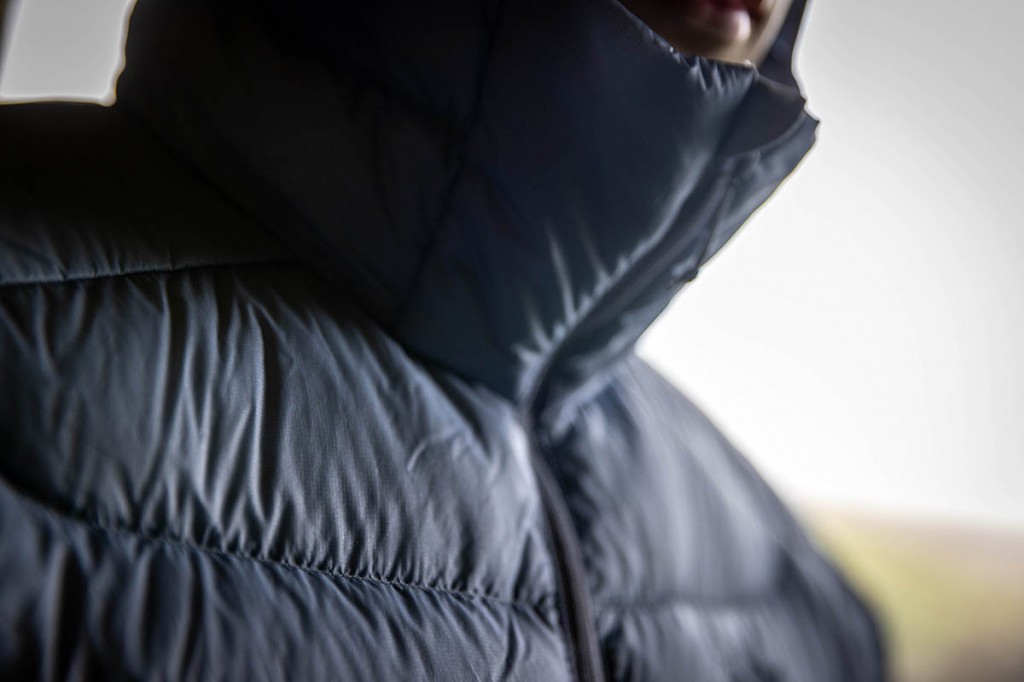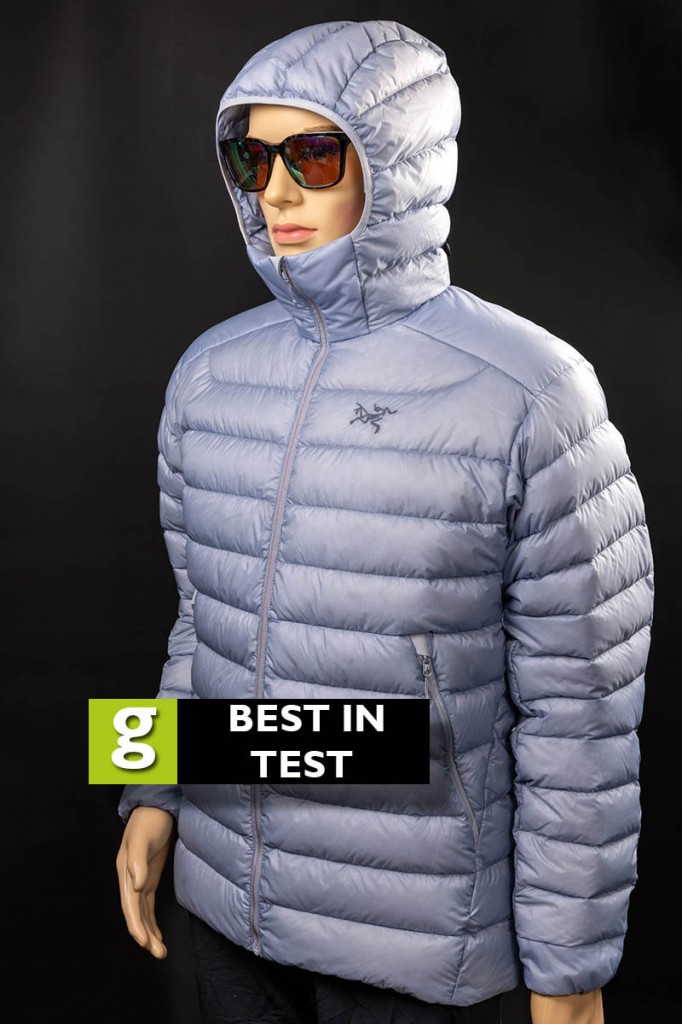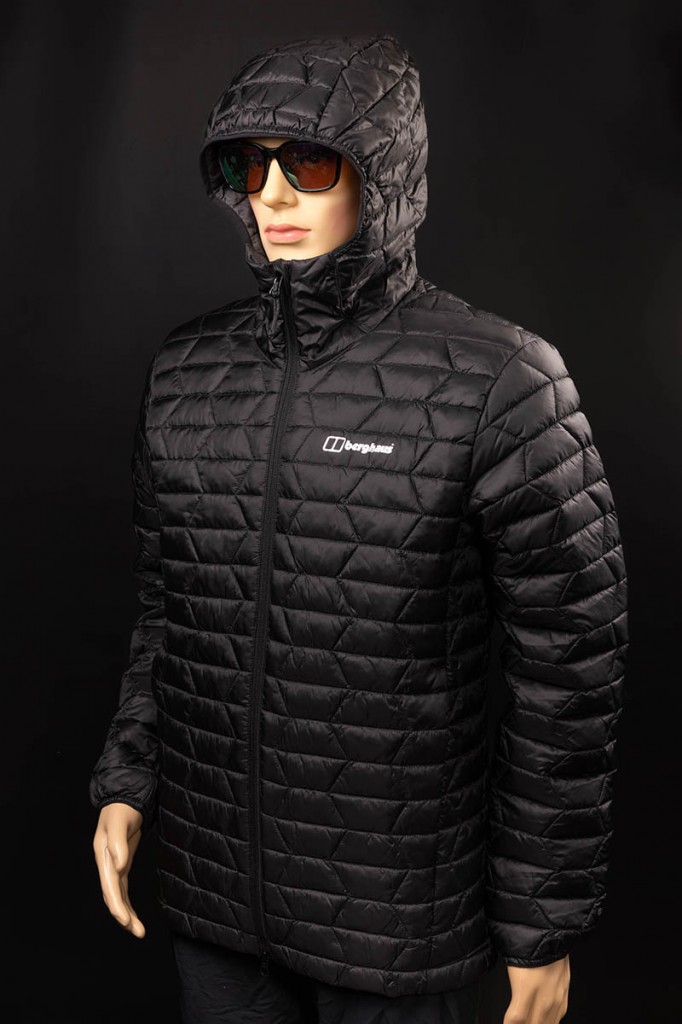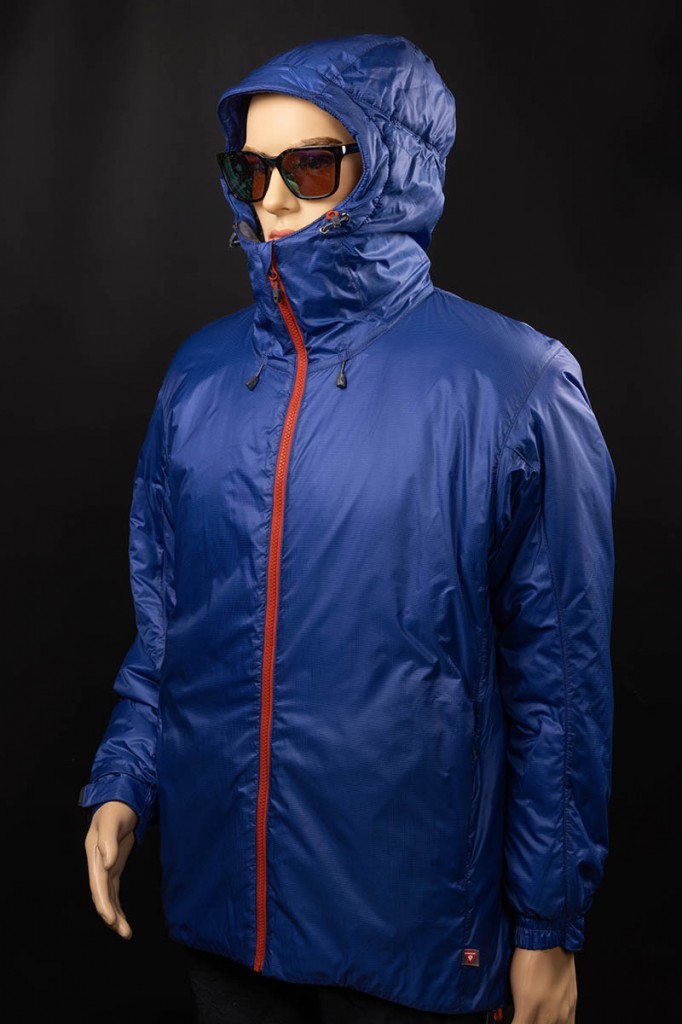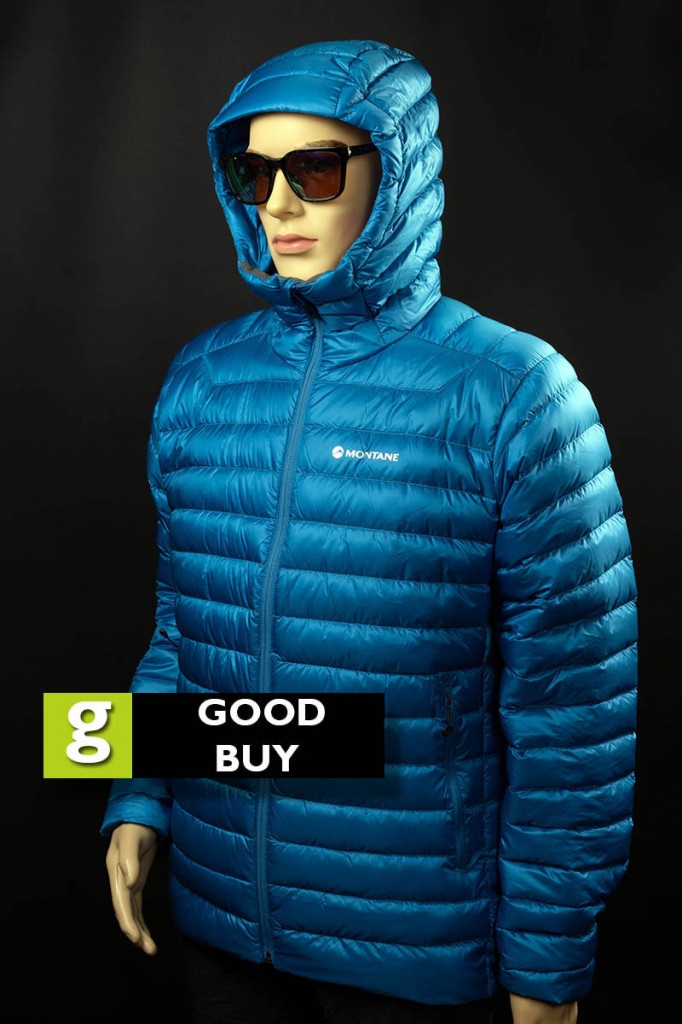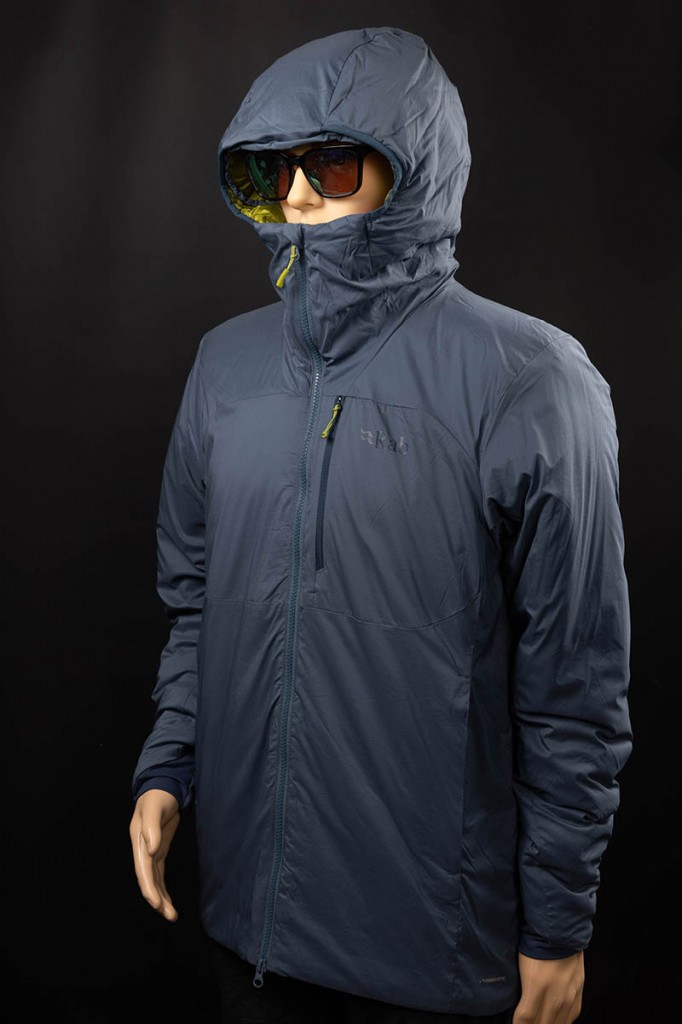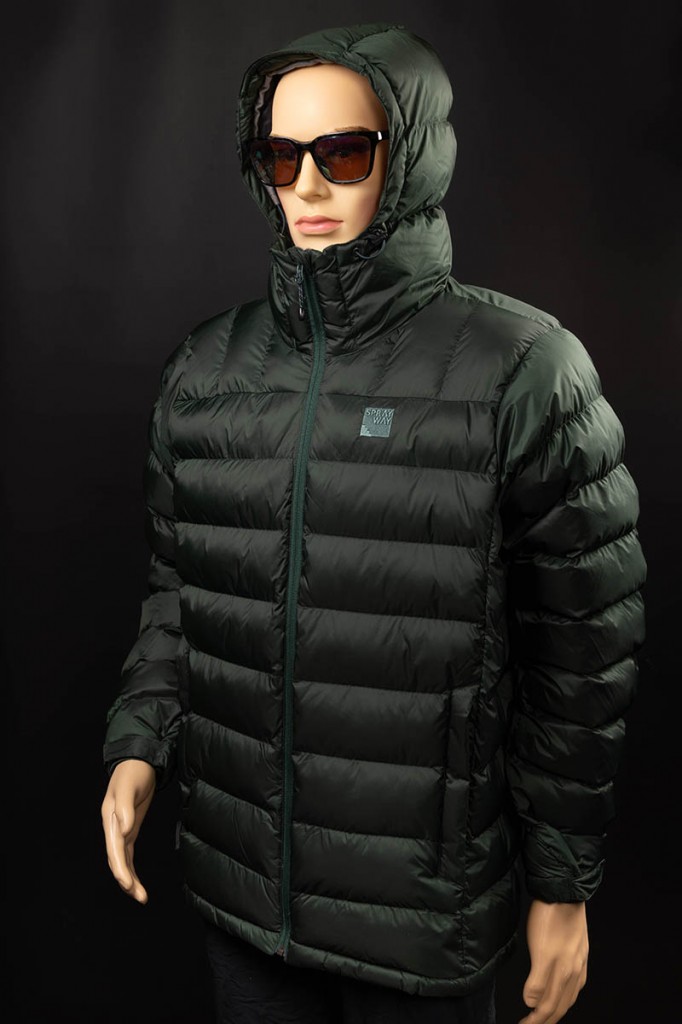A good insulated jacket will help keep out the chill on those cold days when the wind whips up and the temperature drops.
For situations such as those hilltop lunches to cold nights at camp, an insulated top is a useful addition to a walker’s pack.
The main choice to be made is between traditional down-filled jackets and those containing synthetic – normally polyester – insulation. The former has significant advantages: for its weight, down, either duck or goose, offers the best warmth for weight, and also packs down smaller.
But down loses its insulating properties when damp or wet, which in a climate such as the UK’s is a big consideration. But recent developments in treating down fillings with hydrophobic chemicals complicate matters, and many brands now use treated goose or duck down, more commonly with fluorocarbon-free chemicals.
Another consideration with down is its ‘fill power’. This is a figure that essentially denotes the quality of the down used. The higher the fill power number, the better its insulating properties, so a smaller quantity can be used to provide the same warmth.
Obviously, down-filled jackets are not suitable for vegans.
Synthetic filling is usually polyester, in the form of sheets of woven filaments or, less commonly, ‘blown’ clusters of the yarn, which are held to mimic better the way down works.
Synthetic insulation tends to be heavier and less able to be compressed, leading to bigger packed sizes and a slightly bigger load in the pack or on the back. Polyester-filled jackets have traditionally been cheaper too but on the evidence of our samples, the price difference is less marked than previously.
Damp, affecting the insulation, can come from inside the garment as well as from the weather. If you’re undertaking any strenuous activity, such as hillwalking or climbing, you’re likely to produce perspiration which, over a length of time, may compromise the ability of the jacket to maintain insulation, particularly with down.
Some of the jackets in this test have a durable water-resistant treatment added to their shell and lining fabrics too. The outdoors industry is moving away from the perfluorinated chemicals that are viewed as harmful to the environment and potentially to humans. The DWR treatment will provide some repellency to rain and showers, but none of the jackets should be considered waterproof.
The jackets in the test were evaluated in a variety of conditions and activities.
Arc’teryx Cerium Hoody
Price: £350
Colour: pale blue
Weight: 330g including stuffsack
Material: recycled nylon
Insulating material: goose down/Coreloft synthetic
Country of manufacture: Vietnam
Women’s version: yes
Sizes: men’s XS-XXXL; women’s XXS-XXL
The Arc’teryx jacket is the lightest in the test, and uses 850 fill-power goose down for most of its insulation, with small areas subject to more moisture containing Coreloft 100g/m² or 80g/m² bluesign-approved polyester insulation, with 80 per cent recycled material.
The high fill-power European white goose down providing good warmth for a lower weight.
The Cerium Hoody has a fitted cut, which keeps the jacket close to the body, aiding maximum insulation. Arc’teryx recommends wearing the Cerium over a baselayer or under a third layer. The company describes it as an all-round jacket for use in cold dry conditions.
The outer shell is made from 15 denier Arato recycled nylon, which Arc’teryx says is durable despite its lightweight construction. The material stood up to use while on test. The lining uses a bio-derived nylon material from 60 per cent castor bean oil, which the brand says provides the same benefits as synthetic nylon but with less use of fossil-derived material.
The shell has a non-fluorocarbon durable water resistant treatment. This will repel some moisture, both from within and outside, but the jacket is not waterproof.
The hood fits well and has a rear adjuster with a spring-toggle. It cinched the hood well round the face, and stayed up in strong headwinds, and turned well with the head when cinched in.
The rear hem is dropped slightly at the rear and the jacket hem has a drawcord with two adjusters at the hip area.
The Cerium Hoody had good windblocking qualities and provided good warmth on cold days. It has two zipped handwarmer pockets and an internal zipped chest pocket which also contains a tethered stuffsack. The jacket packs down small into the stuffsack, just 23cm x 13cm.
The sleeves are slightly articulated and their cuffs are elasticated, doing a good job of keeping out draughts.
Overall, the Cerium Hoody was very comfortable and warm enough with just a baselayer under it on all but the coldest days. It allowed good movement, resisting riding up when I reached up. After sustained activity, including fast walking, there was some decrease in the insulating properties of the down, which is to be expected with this kind of filling. A couple of light showers didn’t trouble the jacket thought.
To keep weight to a minimum, the jacket’s zip has only a single puller, which might be a disadvantage if you’re using it while climbing and need to access your harness or other items.
The Arc’teryx jacket comes into its own for stops on cold, dry days. Pulling it on at the hilltop stop provided instant warming. It’s also good on the campsite or on at other times when good insulation is needed while stationary. It’s less suited to high-energy activities or when moving fast up the hill.
The Cerium Hoody scores well on sustainability. The shell uses dope-dyed material, which uses less energy and water in the dyeing process, and the jacket contains bluesign-approved materials. The polyester insulation is also 80 per cent recycled. The down meets the Responsible Down Standard, and the use of plant-derived material in the lining reduces reliance on fossil-sourced fabrics. The water-repellent treatment is fluorocarbon-free.
Arc’teryx says it designs its gear to last. It says it was an early signatory to the UN Fashion Industry Charter for Climate Action, is a member of the Outdoor Industry Association’s Climate Action Corps, a co-founder alongside the Pembina Institute of the Catalyst Business Coalition and one of the first 400 companies to set a verified Science Based Target.
It has a repair facility at its Vancouver headquarters and says, if a garment can’t be repaired, it works to place useable items with programmes that enable it to be used, for instance, by youth groups.
The company is working with the ocean pollution research programmme at Ocean Wise. The project is ‘fingerprinting’ 30 different Arc’teryx textile samples and measuring rates of fabric shedding to understand the problem of microplastics.
The Cerium Hoody quality was very good.
With the quality and the use of more sustainable materials comes a cost, and the Arc’teryx jacket was the most expensive in the test. But durability should be good and performance was also very good.
Best uses: stops on cold, dry days; belaying on dry days; camping; moderate activity on cold dry days.
Warmth 34/40
Packability 18/20
Windblocking 8/10
Sustainability 9/10
Quality 8/10
Value for money 6/10
Total score: 83/100
Berghaus Cuillin Insulated Hoody
Price: £190
Colour: black
Weight: 386g
Material: polyester shell; polyamide lining
Insulating material: Hydroloft polyester
Country of manufacture: Vietnam
Women’s version: yes
Sizes: men’s XS-3XL; women’s 8-20
The Cuillin jacket uses Berghaus’s Hydroloft synthetic insulation anchored by a combination of horizontal stitching and hexagonal panels, giving the hoody a distinctive pattern.
The insulation isn’t bulky, keeping the weight down to little more than the down jackets. This provided a medium level of warmth.
The insulation held up quite well during hillwalking outings. While there was some build-up of moisture inside the jacket, there was only a slight drop in warmth.
The Cuillin’s Pertex Quantum shell has a PFC-free durable water resistant treatment and, while not making the jacket waterproof, it actually kept at bay persistent misty drizzle on one of my excursions onto the moors.
Windproofing was good, with very little wind penetration even on days with near-gale-force conditions. The main zip has a double puller, useful if you need to adjust inner layers or a harness.
The jacket has a scooped back and is a fairly close fit, helping keep in the body’s warmth. There are two zipped handwarmer pockets, half-hidden by small baffles. Inside the pockets are the adjusters for the hem’s drawcord, allowing the bottom of the hoody to be cinched in to keep out updraughts. Slackening is via spring toggles in the hem.
The hoody also has a zipped internal chest pocket, which also doubles as the garment’s stuffsack. For a synthetic-fill jacket, it compresses fairly well, into a 30cm x 15cm pack.
The hood has an elasticated edge and there’s a soft tricot chinguard, but there’s no adjustment for the hood, so it can’t be cinched in tight around the face. Because of this, in headwinds it allows quite a bit of air in around the face, and the hood is pushed back somewhat. It also doesn’t turn with the head. The Cuillin would certainly benefit from some form of hood adjustment.
The sleeves have elasticated cuffs which did a good job of keeping out draughts.
The Berghaus jacket was comfortable in use, but did ride up a little when reaching up for hand placements.
The Cuillin Insulated Hoody’s synthetic insulation and durable water resistant treatment made it a good choice for active use in the UK’s damp climate, with the polyester filling retaining most of its insulating properties, even when perspiration and drizzle were in evidence.
The jacket’s main fabrics are bluesign approved and it’s one of Berghaus’s Madekinder range, containing some recycled content. The water-resistant treatment contains no fluorocarbons.
The Cuillin can also be repaired using the Repairhaus facility run by the brand. The user has to pay for the return of the garment to Berghaus, but the actual repair is free. Rips can be stitched and zips replaced if possible. The company said it has made 5,000 repairs since 2021.
More than half its clothing products are now Madekinder, with more than 50 per cent recycled or bio-based content..
It planted two million trees in 2021 and intended to match this in 2022 and has also donated £35,000 to environmental causes. Its internal squads champion sustainability, diversity, inclusion and charities. Its career development includes modules on sustainability.
Berghaus is a member of the Sustainable Apparel Coalition, the Leather Working Group and the Microfibre Consortium. It uses 100 per cent renewable energy at its headquarters and encourages staff to walk, cycle, car-share or use public transport.
Best uses: hillwalking; climbing; country walking; camping; urban; travel.
Warmth 32/40
Packability 16/20
Windblocking 8/10
Sustainability 8/10
Quality 8/10
Value for money 7/10
Total score: 79/100
Keela Solo Jacket
Price: £154.95
Colour: blue
Weight: 705g
Material: Flylite Ultra Cordura polyester
Insulating material: PrimaLoft polyester
Country of manufacture: not stated
Women’s version: yes
Sizes: men’s XS-2XL; women’s 8-20
The Solo jacket uses PrimaLoft Gold synthetic insulation, which makes it a good choice for the UK’s damp conditions.
Keela have packed quite a lot of insulation into the jacket, giving the user plenty of warmth. It was also good at windblocking, but these were at the cost of a slightly bulkier jacket and a fairly weighty one – the second heaviest in the test.
The Flylite shell has a small ripstop pattern and includes Cordura for good durability. The cut is normal rather than athletic and the Solo allowed good movement and didn’t ride up when reaching up for holds. The back is scooped and the hem has a drawcord adjuster with spring toggles, allowing it to be cinched in to keep out updraughts.
There are twin zipped handwarmer pockets with an outer tricot lining which felt warm. The jacket also has an inside zipped pocket. This is a good size – big enough to take an OS map.
The hood is a little on the small side, but has good adjustment, with both a rear halo-type cord and twin front shockcords with spring toggles. This kept the hood in place well in headwinds, and enabled it to turn with the head. It also has a wired peak.
The sleeves are slightly articulated and have hook-and-loop adjustment strips at the cuffs, which are half-elasticated too.
Warmth from the Keela jacket was good. The sleeves use 100g/ m² PrimaLoft Gold polyester insulation, with a beefier 133g/ m² version in the main body of the garment. Breathability of the Solo was quite good, though there was a slight build-up of perspiration when pushing hard uphill.
The outer shell shed light showers and there was no significant drop in insulation when the jacket got damp, either from the inside or outside.
Packability wasn’t as good as some of the jackets, though I did stuff it down into a 24cm x 20cm sack. The synthetic insulation made for a heavier garment than the down jackets or those with thinner filling.
The Keela jacket was the most competitively priced in the test, so for anyone with a keen eye on their budget, the Solo represented good value for money.
Keela doesn’t supply much detail about the Solo’s sustainability. The company is a signatory of the Sustainable Clothing Action Plan. It says it is boycotting harmful substances such as PVCd and PTFE laminates. It also says it uses sustainable sources for its materials and donates unneeded fabric to charities and designs its garments to last.
Keela runs a clothing hospital for repairs such as broken zips or torn seams and has launched its Legacy Project, through which prototype garments and those which have been repaired are offered for sale at reduced prices. The scheme also uses fabric from garments that have reached the end of their life, creating items such as wash bags.
Keela owns the factories it uses to produce its range. It has also now started using the facilities it set up in Scotland to manufacture clinical gowns during the Covid-19 pandemic to produce a range of limited-edition products.
Best uses: UK hillwalking; UK mountain walking; belaying; active winter walking; camping.
Warmth 34/40
Packability 12/20
Windblocking 8/10
Sustainability 7/10
Quality 7/10
Value for money 9/10
Total score: 77/100
Montane Anti-Freeze Hoodie
Price: £200
Colour: blue
Weight: 382g
Material: recycled nylon
Insulating material: water-resistant duck down
Country of manufacture: Cambodia
Women’s version: yes
Sizes: men’s S-XXL; women’s 8-18
The Montane jacket uses 750+ fill-power down for insulation, and is the second lightest in the test.
This updated version of the Featherlite Down Jacket has narrow baffles to keep the filling in place and the 140g of duck down has fluorocarbon-free HyperDry water-resistant treatment to help it maintain insulation when damp.
The outer shell is recycled Pertex Quantum Eco with a subtle ripstop pattern. This is also treated with a PFC-free durable water resistant finish.
The Anti Freeze Hoodie is an athletic fit, hugging the body, which helped keep in the heat and keep out draughts. The hem has drawcord adjustment with two spring-toggle locks to cut down updraughts on windy days. The hem is dropped at the rear to provide extra protection in that area.
The Montane jacket has two zipped hand warmer pockets, the right-hand one containing a tethered stuffsack. The hoodie packs down to a very compact 24cm x 13cm. There’s also a good sized zipped interior chest pocket.
There are twin tricot lined areas at the chinguard, which were comfortable in use. The hood has a soft peak, but there is no rear volume adjustment. It does, however, have two front shockcord adjusters, which allowed the hood to be cinched in well round the face, staying up in headwinds and allowing the hood to turn with the head.
The jacket’s sleeves have elasticated cuffs, though these didn’t form a very tight seal round the wrist.
The Anti Freeze Hoodie was comfortable in use, providing good warmth for its light weight. Windblocking was good and the DWR treatment repelled light rain showers. Breathability was good, too, and the down filling kept a fair amount of its insulating properties even after strenuous uphill walking created internal moisture.
Fit of the jacket was slightly on the snug side of average, so try on before you buy.
The Anti Freeze is a conventional down jacket that worked well in the hills and mountains on cool to cold days. The hydrophobic treatment of the filling helps to a degree but, as with all down jackets, it’s best suited to activities where you’re not going to produce a lot of perspiration or encounter persistent rain.
The Montane jacket uses 100 per cent recycled fabric in both its outer shell and lining material. Both have PFC-free durable water resistant treatments. The water-resistant treatment of the down is also fluorocarbon free. The down is Responsible Down Standard and Track My Down certified.
Montane says it is working with its suppliers to help limit the effect of microplastics in its products. It has information on how consumers can reduce this impact by, for instance, washing garments less often and using wash bags that capture microfibres.
It uses recycled low density polyethylene in its polybags. It has also begun introducing recycled down into some of its range.
Best uses: hillwalking; winter country walking; belaying, camping.
Warmth 34/40
Packability 18/20
Windblocking 8/10
Sustainability 8/10
Quality 7/10
Value for money 7/10
Total score: 82/100
Rab Xenair Alpine Jacket
Price: £195
Colour: blue
Weight: 458g
Material: Pertex Quantum Air polyamide with acrylic coating
Insulating material: PrimaLoft Gold Active+ 55 per cent recycled polyester
Country of manufacture: Myanmar
Women’s version: yes
Sizes: men’s S-XXL; women’s 8-16
The Xenair Alpine Jacket uses PrimaLoft’s synthetic insulation to provide a good level of warmth.
The Alpine designation marks it apart from its lighter cousin, but its characteristics suit the UK climate well, and the Rab jacket turned in a good performance during some typically cold, wet days.
The Gold Active+ polyester filling is body mapped, with dual density sheet insulation, 100g/m²and 80g/m², providing the warmth where it’s needed most. The jacket worked well when pushing the pace, with very little moisture build-up , and just the right amount of insulation against the elements. Breathability was good.
Even on a day with persistent, rain-driven misty drizzle, the Pertex Quantum Air outer shell resisted the wetness for a prolonged period, and I didn’t notice any marked reduction in warmth. Wind blocking was good.
The jacket has a two-way zip with dual pullers, useful for reaching inside layers or a harness if climbing. There are two zipped handwarmer pockets, semi-hidden behind a small baffle, the left-hand one doubling as a stuff sack. I managed to pack the Xenair Alpine down to 26cm x 14cm, which is not bad for a jacket with synthetic filling.
There’s also a smallish zipped chest pocket. The jacket hem is dropped at the rear, and has a drawstring with spring-toggle adjustment, for cinching in to keep out the wind.
The sleeves are articulated and have cuffs with an elasticated triangular section. This did make for a snug closure over the wrist, but it was difficult to fit thick winter gloves under the cuff.
The hood is a good size – big enough to go over a helmet, and has elasticated edging round the face area and a rear volume adjuster, which worked well, keeping out headwinds and allowing the hood to turn with the head.
The Rab jacket was comfortable in use. It’s standard fit rather than body-hugging, and didn’t ride up when reaching up for holds.
Warmth was just about right for use when on the move and heading uphill. It really came into its own on damp, blowy British days and resisted drizzle surprisingly well, with the PrimaLoft Gold Active+ filling retaining its insulation.
Weight wasn’t bad for a synthetic jacket, and the shell material stood up well to testing.
The Rab jacket is a good choice if you’re heading out into the UK hills in cool to cold weather, especially on damp days.
The synthetic filling uses 55 per cent recycled polyester. Rab and its sister company Lowe Alpine have eradicated polythene bags when shipping its range direct to customers in the UK and USA, with an intention to expand this to Europe. It is a certified climate-neutral company and is aiming for net-zero by 2030.
Equip Outdoor Technologies UK, the parent company, is a member of the Fair Wear Foundation. Its offices in the UK, USA, Germany and Benelux are powered by 100 per cent renewable electricity, as is its UK warehouse.
Between the 2022 and 2023 winter seasons, it increased the proportion of fluorocarbon-free treatments from 36 per cent to 86 per cent. It is trialling its rental service, to reduce the number of single-use purchases and subsequent non-use or disposal.
Best uses: UK hillwalking; climbing and belaying; high-activity walking; camping.
Warmth 32/40
Packability 16/20
Windblocking 8/10
Sustainability 8/10
Quality 8/10
Value for money 7/10
Total score: 79/100
Sprayway Cateran Jacket
Price: £220
Colour: dark green
Weight: 815g
Material: TecShell Loft polyamide
Insulating material: ThermoSphere blown polyester
Country of manufacture: Vietnam
Women’s version: no
Sizes: S-XXL
The Cateran is Sprayway’s winter insulated jacket, packed with plenty of insulation for cold days on the hills.
The jacket uses ThermoSphere blown polyester rather than sheets of insulation. This mimics the properties of down, and provided a very warm experience on cold days.
The disadvantage is the bulky feel and weight of the Cateran – it’s the heaviest in the test and doesn’t pack down like a jacket that uses down. But, unlike down, the synthetic filling kept its performance even when damp, making the Sprayway jacket a good choice for active use on the hills and mountains of the UK.
The outer shell of the jacket is 40 denier polyamide with a subtle ripstop pattern and it felt robust. It stood up well to the rigours of our testing. It is also treated with a PFC-free durable water resistant finish, which shed showers and drizzle.
The blown polyester insulation is densest in the main torso area, with 195g weighting. The sleeves have less content – 138g – and the hood and collar 47g fill. Overall, the Sprayway jacket felt very warm, even on days when the temperature was around zero and there was a strong windchill. On cool days, I could feel a little build-up of moisture inside the jacket when pushing the pace uphill but the Cateran’s breathability was quite good and, on less energetic sections of outings, the perspiration dissipated.
The jacket has two zipped handwarmer pockets, which are covered by baffles. There’s an inside zipped chest pocket as well as a stretch mesh inner pocket, big enough to take an OS map.
The hem has drawcord adjustment with spring-toggles, for tightening in during windy days.
The sleeves’ cuffs have hook-and-loop tabs for adjustment and are also elasticated, so kept the wind out well. They’re just wide enough to allow gloves to be tucked into them, though it was a struggle with thicker winter gloves.
The hood is not over-large and has only a rear hook-and-loop strip for limited volume adjustment. However, the front shockcord adjusters, with spring toggles, worked well at cinching the hood around the face, keeping out the weather in headwinds. The hood also has a small wired peak.
The jacket comes with a stuffsack, which enabled it to be packed down to 28cm x 18cm.
The Sprayway jacket was ideally suited to cold days when it was possible to keep the bitter windchill at bay while on the move, without the worry of the insulation’s effectiveness diminishing. The DWR treatment of the shell also kept showers out.
The downside is the Cateran’s weight and inability to pack down small. However, it didn’t feel over-bulky in use and has useful features such as the map pocket.
The Sprayway jacket uses PFC-free water-resistant treatment. The brand’s parent company, the Bollin Group, works with the Fair Wear Foundation on monitoring working conditions. Sprayway doesn’t provide much more about the jacket’s sustainability.
Best uses: hillwalking; Scottish mountain walking; camping; winter walking.
Warmth 35/40
Packability 13/20
Windblocking 8/10
Sustainability 5/10
Quality 7/10
Value for money 7/10
Total score: 75/100
The Arc’teryx Cerium LR Hoody topped the test results, with good performance, excellent packability and sustainability credentials beating the other contenders, though at a high price.
The other down jacket, the Montane Anti Freeze Hoodie, was close behind, and also performed well.
In the garments using synthetic fillings, the Berghaus Cuillin Insulated Hoody and the Rab Xenair Alpine Jacket were equally impressive and a similar price.
For value, the Keela Solo Jacket was unbeatable, while the Sprayway Cateran Jacket was the warmest in the test, so if these are your criteria, these two contenders are worth considering.
- All the jackets in the test were supplied to grough by the brands.
